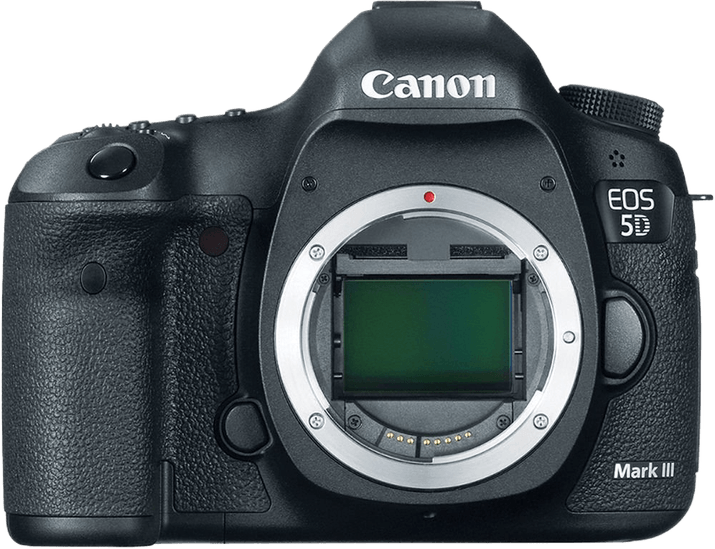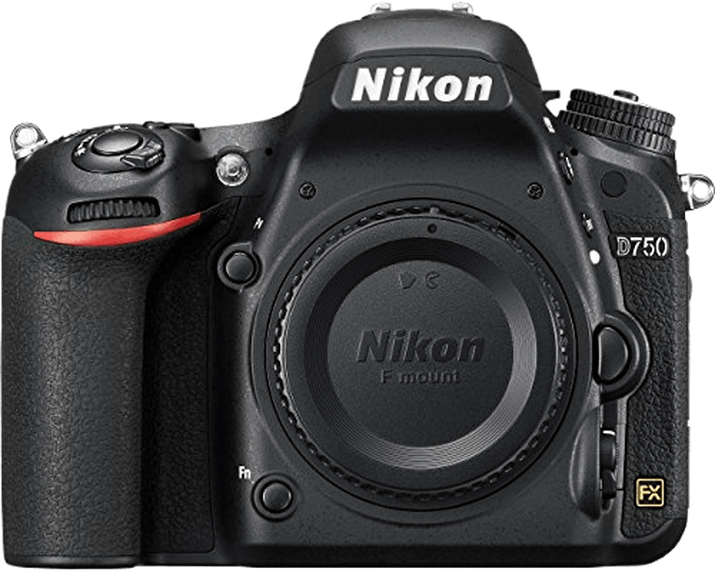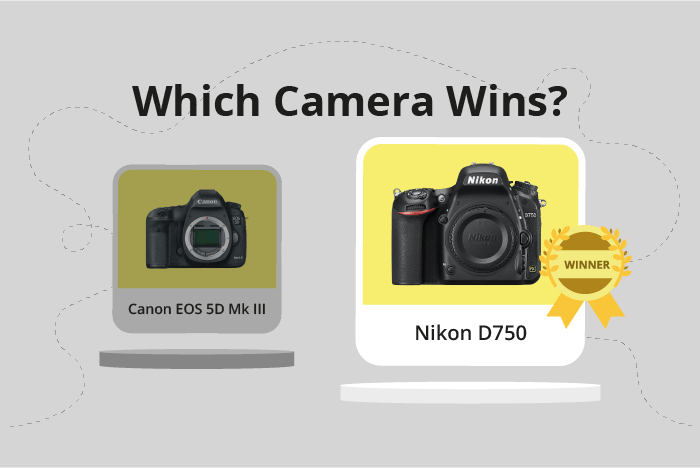Canon EOS 5D Mark III vs Nikon D750 Comparison
Canon EOS 5D Mark III

Nikon D750

The Nikon D750 emerges as the winner with a score of 68/100, while the Canon EOS 5D Mark III trails slightly behind with a score of 65/100. Both cameras are DSLRs and were released in 2012 and 2014, respectively. They share similarities in their camera type and size, with the Canon measuring 152 x 116 x 76mm and the Nikon at 141 x 113 x 78mm.
The Nikon D750 outperforms the Canon in terms of weight and price. It weighs only 750g (1.65lbs), making it lighter than the Canon, which weighs 950g (2.09lbs). Additionally, the Nikon has a more affordable launch price of $2300, compared to the Canon’s $3499.
On the other hand, the Canon EOS 5D Mark III doesn’t offer any significant advantages over the Nikon D750 based on the provided specifications. Therefore, the Nikon D750 seems like the superior choice due to its lighter weight and more budget-friendly price.
Canon EOS 5D Mark III vs Nikon D750 Overview and Optics
The Nikon D750 triumphs over the Canon EOS 5D Mark III in optics, with a score of 71/100 compared to the Canon’s 67/100. Both cameras share common specifications such as a CMOS sensor, full-frame sensor size, and the absence of image stabilization. Furthermore, they have similar lens mounts, with the Canon utilizing the EF mount and the Nikon using the F FX mount.
The Nikon D750 outperforms its competitor in several aspects. It boasts a higher megapixel count at 24.3, as opposed to the Canon’s 22.3, allowing for more detailed images. Additionally, the Nikon has a faster shooting speed of 6.5 frames per second, compared to the Canon’s 6 frames per second, making it more suitable for capturing fast-moving subjects. The D750 also has a superior DXOMARK score for its sensor at 93, while the Canon scores 81, indicating better overall image quality.
On the other hand, the Canon EOS 5D Mark III does not have any significant advantages in optics over the Nikon D750. However, it does feature a slightly more advanced processor, the Digic 5+, as opposed to the Nikon’s Expeed 4, which may contribute to better image processing capabilities.
Taking these factors into account, the Nikon D750 stands as the better choice for those prioritizing optics. Its higher megapixel count, faster shooting speed, and superior DXOMARK score for its sensor make it a more appealing option for capturing high-quality images. While the Canon EOS 5D Mark III does have a marginally better processor, it does not offer any substantial advantages in optics to outshine the Nikon D750.
Canon EOS 5D Mark III vs Nikon D750 Video Performance
When comparing the video capabilities of the Canon EOS 5D Mark III and the Nikon D750, both cameras receive an identical score of 56/100. This indicates that they offer similar performance in terms of video recording. However, a closer look at the specifications reveals some differences between the two models.
Both the Canon EOS 5D Mark III and the Nikon D750 share common video specifications, such as Full HD video resolution, maximum video dimensions of 1920 x 1080, and a maximum video frame rate of 60fps. Additionally, neither camera has time-lapse functionality built in.
Despite their identical scores, there are aspects where one camera may be considered better than the other. The Canon EOS 5D Mark III is known for its exceptional image quality and color reproduction in video, which may appeal to filmmakers and videographers who prioritize these features. On the other hand, the Nikon D750 is praised for its excellent low light performance and dynamic range, making it a strong contender for those who frequently shoot in challenging lighting conditions.
In terms of video capabilities, both the Canon EOS 5D Mark III and the Nikon D750 offer comparable performance, with each having its own strengths. Ultimately, the choice between these two cameras will depend on the specific needs and preferences of the user.
Canon EOS 5D Mark III vs Nikon D750 Features and Benefits
The Canon EOS 5D Mark III and Nikon D750 both have a feature score of 59/100. Despite having the same score, each camera has its unique features that make it stand out.
Both cameras have a 3.2-inch screen, but the Nikon D750 has a higher screen resolution of 1,229,000 dots compared to the Canon 5D Mark III’s 1,040,000 dots. Neither camera has a touchscreen or GPS. Additionally, both cameras lack Bluetooth connectivity.
The Nikon D750 has a flip screen and Wi-Fi capability, which the Canon 5D Mark III does not have. The flip screen allows for more versatile shooting angles and easier self-portraits, while the Wi-Fi functionality enables wireless file transfer and remote camera control. These features give the Nikon D750 an edge over the Canon 5D Mark III.
On the other hand, the Canon 5D Mark III does not have any specific features that make it superior to the Nikon D750. However, it is important to note that the overall performance and quality of a camera are not solely dependent on its features. Other factors, such as image quality, autofocus performance, and ergonomics, play a significant role in determining the better camera.
Considering the features of both cameras, the Nikon D750 takes the lead with its flip screen and Wi-Fi capabilities. However, the Canon 5D Mark III remains a strong competitor, and the choice between the two cameras ultimately depends on the individual needs and preferences of the photographer.
Canon EOS 5D Mark III vs Nikon D750 Storage and Battery
The Nikon D750 triumphs over the Canon EOS 5D Mark III in storage and battery with a score of 79/100, compared to the Canon’s 76/100. Both cameras share similarities, such as having two memory card slots and supporting SD, SDHC, and SDXC cards. However, the Canon 5D Mark III also accepts Compact Flash and UDMA cards, providing more storage options.
The Nikon D750 outperforms the Canon 5D Mark III in battery life, offering 1230 shots per charge with its EN-EL15 battery, while the Canon’s LP-E6 battery yields 950 shots. Neither camera has USB charging capabilities.
Although the Canon 5D Mark III has additional storage compatibility, the Nikon D750’s superior battery life makes it a better choice for photographers needing longer shooting sessions.
Alternatives to the Canon EOS 5D Mark III and Nikon D750
Are you still undecided about which camera is right for you? Have a look at these popular comparisons that feature the Canon EOS 5D Mark III or the Nikon D750:

